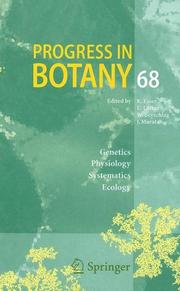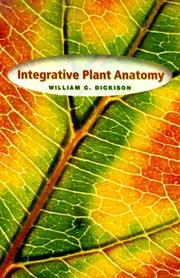| Listing 1 - 10 of 284 | << page >> |
Sort by
|
Book
ISBN: 8024632470 9788024632476 9788024618678 Year: 2017 Publisher: [Praha]
Abstract | Keywords | Export | Availability | Bookmark
 Loading...
Loading...Choose an application
- Reference Manager
- EndNote
- RefWorks (Direct export to RefWorks)
Učební text "Anatomie rostlin" shrnuje základní poznatky o stavbě rostlin. Jednotlivé kapitoly jsou věnovány rostlinné buňce, pletivům, primární a sekundární stavbě vegetativních orgánů a reprodukčním orgánům. V úvodní části je shrnuta historie rostlinné anatomie a její postavení v současné biologii rostlin a jsou stručně charakterizovány základní skupiny rostlin. Text zdůrazňuje vztah struktury pletiv a orgánů k jejich funkcím a popisuje i strukturní adaptace k podmínkám prostředí. U nejdůležitějších struktur je zmíněna jejich evoluce. Text je určen v prvé řadě pro základní kurzy anatomie rostlin, jednotlivé kapitoly však obsahují rozšiřující údaje, které jsou vhodné i pro pokročilejší kurzy.
Plant anatomy. --- Botany --- Plant structure --- Plants --- Structural botany --- Vegetable anatomy --- Anatomy --- Structure
Book
ISBN: 2225464316 9782225464317 Year: 1977 Publisher: Paris: Masson,
Abstract | Keywords | Export | Availability | Bookmark
 Loading...
Loading...Choose an application
- Reference Manager
- EndNote
- RefWorks (Direct export to RefWorks)
Plant anatomy --- Atlases --- -Botany --- Plant structure --- Plants --- Structural botany --- Vegetable anatomy --- Anatomy --- Botany --- Structure --- -Atlases --- Plant biology
Book
ISBN: 9780813827186 0813827183 Year: 2009 Publisher: Iowa (Iowa) Wiley-Blackwell
Abstract | Keywords | Export | Availability | Bookmark
 Loading...
Loading...Choose an application
- Reference Manager
- EndNote
- RefWorks (Direct export to RefWorks)
"The Structure and Function of Plants provides an important introduction and overview of the anatomy and physiology of plants. The chapters are designed to provide the reader with valuable insight into how plants work and respond to their growing environment. The information is presented in a user-friendly format that provides thorough explanations of key plant structures and how they interact with their environments to survive and flourish." "The Structure and Function of Plants opens with descriptive chapters that acquaint readers with key plant structures such as roots, stems, leaves, and flowers. The remaining chapters describe the inner workings of plant life, looking at how plants extract water and nutrients from the soil, convert sunlight into carbohydrates, and manage to survive and reproduce while rooted in one spot. Each chapter is highly illustrated with vibrant full-color images that aid in reinforcing and demonstrating key concepts." "Providing a unique coverage of the basics of plant anatomy and physiology, The Structure and Function of Plants, is a valuable resource for introductory students, professionals, and plant enthusiasts."--BOOK JACKET.
Botany --- Plant anatomy --- Plant physiology --- Pflanzenanatomie. --- Pflanzenphysiologie. --- 581.1 --- Plantkunde --- Plantenfysiologie --- 581.1 Plant physiology --- Plants --- Physiology --- Plant structure --- Structural botany --- Vegetable anatomy --- Anatomy --- Structure
Book
ISBN: 0805345701 Year: 1988 Publisher: Menlo Park, Calif. Benjamin Cummings
Abstract | Keywords | Export | Availability | Bookmark
 Loading...
Loading...Choose an application
- Reference Manager
- EndNote
- RefWorks (Direct export to RefWorks)
Phytomorphology. Phytoanatomy --- Plant anatomy --- #WPLT:syst --- Botany --- Plant structure --- Plants --- Structural botany --- Vegetable anatomy --- Anatomy --- Structure --- ANA Anatomy & Morphology --- anatomy --- cytology --- morphology
Book
ISBN: 9781108749121 9781108782104 1108749127 Year: 2020 Publisher: Cambridge Cambridge University Press
Abstract | Keywords | Export | Availability | Bookmark
 Loading...
Loading...Choose an application
- Reference Manager
- EndNote
- RefWorks (Direct export to RefWorks)
"Understanding plant anatomy is not only fundamental to the study of plant systematics and palaeobotany, but is also an essential part of evolutionary biology, physiology, ecology and the rapidly expanding science of developmental genetics. This modernised new edition covers all aspects of comparative plant structure and development, arranged in a series of chapters on the stem, root, leaf, flower, pollen, seed and fruit. Internal structures are described using magnification aids from the simple hand-lens to the electron microscope. Numerous references to recent topical literature are included, and new illustrations reflect a wide range of flowering plant species. The phylogenetic context of plant names has been updated as a result of improved understanding of the relationships among flowering plants. This clearly written text is ideal for students studying a wide range of courses in botany and plant science, and is also an excellent resource for professional and amateur horticulturists"-- Provided by publisher
Angiosperms --- Plant anatomy --- Anatomy --- Plant anatomy. --- Angiospermes --- Plantes --- Anatomy. --- Anatomie --- Anatomie. --- Botany --- Plant structure --- Plants --- Structural botany --- Vegetable anatomy --- Flowering plants --- Magnoliophyta --- Phanerogams --- Structure --- Angiosperms - Anatomy
Book
ISBN: 849048788X 8490485097 8490486298 Year: 2017 Publisher: Valencia Universitat Politècnica de València Editorial
Abstract | Keywords | Export | Availability | Bookmark
 Loading...
Loading...Choose an application
- Reference Manager
- EndNote
- RefWorks (Direct export to RefWorks)
Are children under 2 years old exposed to apps? Which ones? How often? What kind of apps would be best suited for small children based on their physical and cognitive development, the evolution of their play patterns and their ability to interact with mobile devices? How to design apps as appropriate as possible for children under 2 years old? These are some of the main questions that are answered through the research presented in this publication. An investigation that demonstrates that children under 2 years of age in Spain are playing with apps and highlights the relevance of generating supporting documentation, for improving the use and the design of apps for such a vulnerable target. The research presents pioneering information for the industry and developers with specific proposals on how to design children's apps taking into consideration children's development and their possibilities in terms of recreational, educational, graphical and interactive content. The information also supports educators and parents when it comes to choosing apps and defining the ways of use that may be most appropriate for each child in each age group.
Madera --- Anatomía vegetal. --- Wood --- Plant anatomy. --- Identificación. --- Conservación y restauración. --- Identification. --- Identification of wood --- Botany --- Plant structure --- Plants --- Structural botany --- Vegetable anatomy --- Anatomy --- Structure

ISBN: 3540368329 3540368302 Year: 2007 Volume: 68 Publisher: Heidelberg : Springer-Verlag,
Abstract | Keywords | Export | Availability | Bookmark
 Loading...
Loading...Choose an application
- Reference Manager
- EndNote
- RefWorks (Direct export to RefWorks)
With one volume each year, this series keeps scientists and advanced students informed of the latest developments and results in all areas of the plant sciences. The present volume includes reviews on genetics, cell biology, physiology, comparative morphology, systematics, ecology, and vegetation science.
Botany. --- Plant anatomy. --- Plant ecology. --- Plant physiology. --- Botany --- Plants --- Physiology --- Ecology --- Plant structure --- Structural botany --- Vegetable anatomy --- Anatomy --- Botanical science --- Phytobiology --- Phytography --- Phytology --- Plant biology --- Plant science --- Biology --- Natural history --- Structure --- Phytoecology --- Vegetation ecology --- Floristic botany --- Floristic ecology
ISBN: 9783211798942 3211798935 9786611965068 1281965065 3211798943 Year: 2009 Publisher: Vienna : Springer Vienna,
Abstract | Keywords | Export | Availability | Bookmark
 Loading...
Loading...Choose an application
- Reference Manager
- EndNote
- RefWorks (Direct export to RefWorks)
This handbook is a fully illustrated compendium of glossary terms and basic principles in the field of palynology, making it an indispensable tool for all palynologists. The general chapter on pollen morphology, anatomy, and pollen development deals with essential aspects of palynology. Where appropriate, ambiguous or poorly recognized aspects are explained in greater detail, based on the present state of knowledge in palynology. The terminology section comprises more than 300 widely used terms illustrated with over 1000 high-quality light and/or electron microscope images. It provides a detailed survey of the manifold ornamentation and structures of pollen walls, and offers insights into their stunning aesthetic beauty. Terms are grouped by context to allow easier and faster comparison of similar features. In general, each term is explained on a page of its own, including the definition, plant species, and, if needed, a comprehensive explanation. The use of the terms in LM, SEM or TEM and their assignment to anatomical, morphological and/or functional pollen features are indicated by icons and color coding, respectively. The textual glossary is arranged alphabetically for faster term searches. Key literature sources are mentioned and select cross-references to the general chapter are included for better comprehension.
General ecology and biosociology --- Systematics. Taxonomy. Nomenclature --- systematische plantkunde --- biodiversiteit --- biogeografie --- General palaeontology --- allergieën --- paleontologie --- Botany --- planten --- Allergy --- Pollen --- Plant anatomy --- Plant structure --- Plants --- Structural botany --- Vegetable anatomy --- Anatomy --- Grains, Pollen --- Pollen grains --- Pollinaria --- Anther --- Palynology --- Pollination --- Structure

ISBN: 1281795348 9786611795344 008050891X 0122151704 Year: 2000 Publisher: San Diego : Harcourt/Academic Press,
Abstract | Keywords | Export | Availability | Bookmark
 Loading...
Loading...Choose an application
- Reference Manager
- EndNote
- RefWorks (Direct export to RefWorks)
From this modern and profusely illustrated book, the reader will learn not just the basics, which are amply reviewed, but also how plant anatomy is integrated with a wide variety of other disciplines, such as plant breeding, forensic analysis, medicine, food science, wood and fiber products, and the arts. The author presents the basic concepts and terminology of plant anatomy with a special emphasis on its significance and applications to other disciplines, and addresses the central role of anatomy by consolidating previously scattered information into a single volume. Integrative Plant Ana
Plant anatomy. --- Botany. --- Botanical science --- Phytobiology --- Phytography --- Phytology --- Plant biology --- Plant science --- Botany --- Plant structure --- Plants --- Structural botany --- Vegetable anatomy --- Anatomy --- Structure --- Biology --- Natural history --- Floristic botany --- plant anatomy --- Plant morphology --- physiological functions --- terminology --- Definition
Book
ISBN: 3662492601 366249258X Year: 2017 Publisher: Berlin : Springer,
Abstract | Keywords | Export | Availability | Bookmark
 Loading...
Loading...Choose an application
- Reference Manager
- EndNote
- RefWorks (Direct export to RefWorks)
About 15 years after the first edition of the Handbook of Aizoaceae, a wealth of changes can be reported for the family Aizoaceae, and this second edition brings a completely new survey over all taxonomic units from subfamilies down to species and subspecies; each critically examined. Of the presently known 2956 species, 1594 have been accepted and are described here, arranged in 147 genera. Six genera have been newly described since 2001, namely Brianhuntleya, Hammeria, Knersia, Phiambolia, Ruschiella, and Volkeranthus, and only one has been placed newly into synonymy (Caulipsilon). All synonymous genus names are treated with the valid genus names. Preliminary molecular studies are referred to, for which different groups of markers at different levels like species, genera, subgenera, and further ranks have been used. The basic division into four subfamilies is supported by more recent studies, yet with some genera being shifted. Furthermore, the geographical distribution of each genus is shown on one map each: either worldwide, or restricted to Southern Africa. For these latter, the main rainfall seasons are delimited by blue lines in order to offer also parameters for cultivation. This second edition provides a comprehensive list of the latest taxonomy including the updated relevant plant data. Following an introduction to the leaf-succulent family Aizoaceae, including keys to the subfamilies and genera, all genera with keys to the subgenera and succulent species are described in detail.
Life sciences. --- Plant ecology. --- Plant anatomy. --- Plant development. --- Life Sciences. --- Plant Systematics/Taxonomy/Biogeography. --- Plant Ecology. --- Plant Anatomy/Development. --- Botany --- Plants --- Ecology --- Plant structure --- Structural botany --- Vegetable anatomy --- Anatomy --- Structure --- Phytoecology --- Vegetation ecology --- Aizoaceae --- Ficoidaceae --- Mesembryanthemaceae --- Tetragoniaceae --- Caryophyllales
| Listing 1 - 10 of 284 | << page >> |
Sort by
|

 Search
Search Feedback
Feedback About UniCat
About UniCat  Help
Help News
News